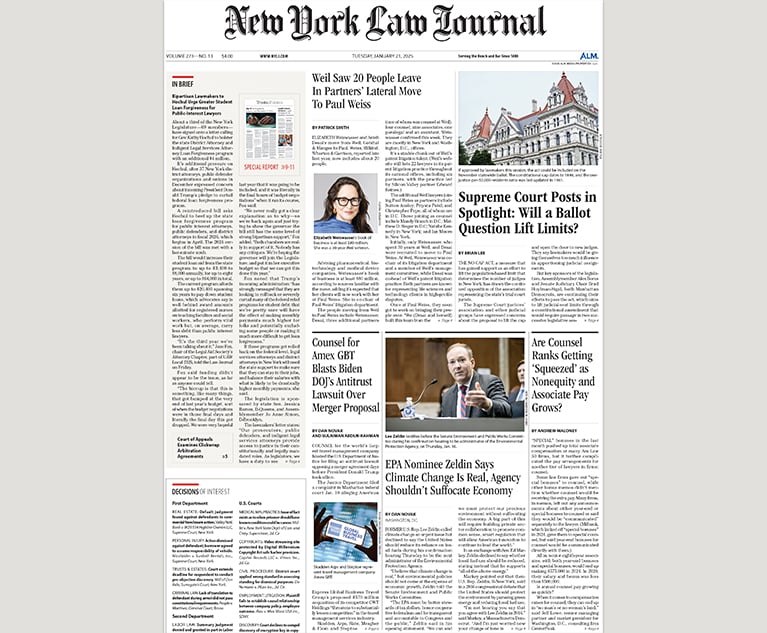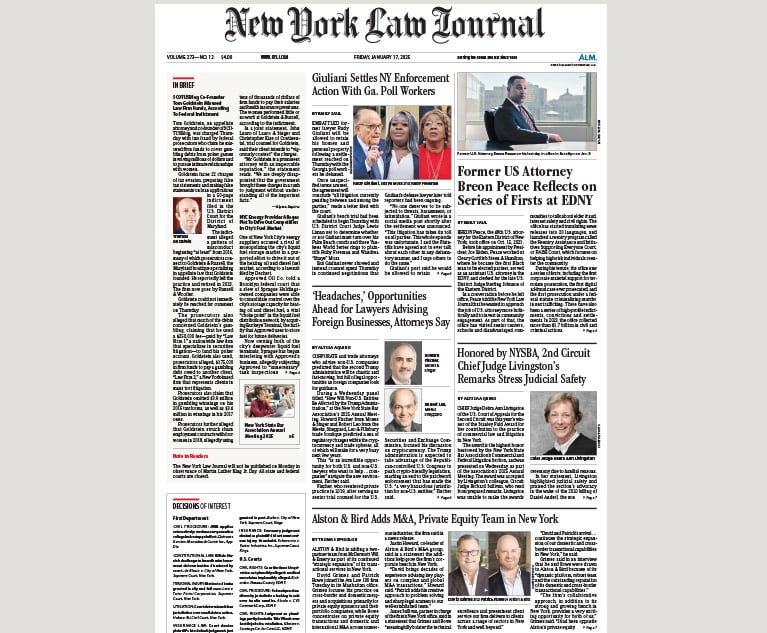NY Firms' Promotions Rose Over Last Year, As Did Share of Female New Partners
In the year before a pandemic disrupted the entire legal market, New York's biggest law firms continued expanding their classes of new partners.
April 20, 2020 at 10:00 AM
7 minute read
 Just before a global pandemic forced scores of large and small firms alike to cut expenses, the biggest law firms in New York continued to grow their classes of newly-minted partners in the last year.
Just before a global pandemic forced scores of large and small firms alike to cut expenses, the biggest law firms in New York continued to grow their classes of newly-minted partners in the last year.
Now legal market observers say the growing promotions at New York's biggest firms—a trend that the New York Law Journal has observed now for the past couple of years—may halt or reverse amid the economic turmoil from the coronavirus pandemic, as law firms look to preserve profit from any remaining business.
The Law Journal tracks partner promotion classes, both firmwide and in New York, of the 25 firms employing the most lawyers in the state, as ranked by the NYLJ 100. The firms range from Paul Weiss Rifkind Wharton & Garrison, with 833 lawyers in New York, to Kramer Levin Naftalis & Frankel, with 279 in the state. The partner promotion figures reported here were collected from press releases as of March 2020.
In the last year, the 25 largest firms promoted more people to partner in the last 12 months compared with the prior year. Collectively, the number of new partners increased by 9.6% firmwide to 536, while new partners in New York increased by 7% to 169 in all, according to a New York Law Journal review of promotion data. A growing share of the new partners were women.
The data includes promotions of all associates and counsel to partner, including both equity and nonequity positions. Some firms in the Law Journal's sample only have equity partners, but more of them have a two-tier partnership.
Many of the promotions in the NYLJ's sample were announced around Jan. 1, when many firms were anticipating a strong 2020 and the coronavirus pandemic was a speck on the horizon. Some firms that promoted new partners after the pandemic started have described the moves as long-term investments. But the sizes of other new partner classes are in doubt.
"In the next round, if things aren't up and running at full capacity, I think firms will be pretty cautious about promotions," said Lisa Smith, a principal of the law firm consulting company Fairfax Associates. "Some [firms] are doing okay, others are telling me revenue is already off, in the last month, 20% or 30%, and in that environment, you just can't maintain the same pool of partners."
Kirkland & Ellis' new partner class, announced last October, had 141 lawyers—the most among the 25 top firms in the Law Journal's analysis. The firm is well known for its large, profitable and high-turnover nonequity tier. Even though it's just the fifth-largest firm in New York in terms of lawyer head count, its 28 in-state promotions amounted to nearly one-sixth of the Law Journal's sample of New York partner promotions.
Firms with other large new partner classes in New York include Latham & Watkins, a global juggernaut that tallied 10 such promotions in its Manhattan office, and Willkie Farr & Gallagher, which had 17. Willkie introduced a nonequity tier in 2018, and the firm's chairmen said in a 2020 interview that they view it as a "stepping stone" to equity for rising associates and some lateral partners.
But the three biggest firms in the state recorded just a single-digit number of partner promotions among lawyers assigned to their New York offices, including Paul Weiss, with seven announced in December 2019; Davis Polk & Wardwell, with seven announced in June 2019; and Skadden, with five announced in April 2019. All three only have equity partners, however, and firms have been much less keen to grow the equity partnership compared to the nonequity ranks.
Indeed, even though large firms have been steadily growing their new partner classes, the total number of equity partners isn't rapidly expanding
Gretta Rusanow, the head of advisory services of the Citi Private Bank's Law Firm Group, said the number of equity partners in Citi's sample of New York City-based firms has been relatively flat over the years. In Citi's sample, the equity ranks rose 0.8% in 2018 and fell 1% in 2019, she said.
Those figures reflect the creation of new equity partners as well as retirements and departures at the firms in the Citi sample. Rusanow noted that the numbers varied widely from firm to firm. "There is a wide dispersion in the equity partner head count movement," she said, noting among the most profitable firms, she did see some growth in equity partner head count last year.
Gender Shifts
The share of new law firm partners in the Law Journal sample who are women continued to grow. 202 out of 536, or about 37.7%, are women. In the prior year, about 34.5% of promoted partners were women.
The growing proportion of female new partners aligns with other data. The Diversity and Flexibility Alliance, for instance, found 41.3% of law firm partners made in 2019 were women, up about two percentage points from the year before. The growth follows scrutiny on partner promotions in the last two years from corporate clients.
Still, the share of all law firm partners who are women last year barely budged, rising from 23.4% to 24.2%, according to a December 2019 report from the National Association for Law Placement. The new partner statistic is below the share of associates who are women, which is 46.8%, according to NALP data.
Manar Morales, the president and CEO of the Diversity and Flexibility Alliance, which counts several law firms as its members, said the number of female new partners may be rising because firms are paying attention to places where unconscious bias can seep into decisions, including work allocation, origination credit and leadership roles. Some firms have also rolled out more flexible-working policies, though she noted that such policies—like eliminating the distinction between primary and secondary caregivers in leave policies—couldn't be viewed as only "women's issues."
"Flexibility is not a women's issue. You have to degender and destigmatize [it]," she said. "As you get more men into care, you get more women into leadership."
Six law firms promoted partner classes over the past year (as of March 2020), that were at least half women: Davis Polk, where women made up half of its 10 new partner class firmwide; Sullivan & Cromwell, with two-thirds of its six new partners women; Weil Gotshal & Manges, with nine women of 16 partners; Ropes & Gray, with the same numbers as Weil; Barclay Damon, where five of seven new partners were women; and Kramer Levin, where three of the four new partners promoted last year were women.
All but one of the 25 firms in the Law Journal's sample promoted at least one woman to partner. Schulte Roth & Zabel, a firm known for its hedge funds practice, was the only firm that made no new women partners in the last year. The firm, which promoted two men to partner, said in a statement that it has promoted and recruited talented women partners in other recent years, including bank regulatory partner Kara Kuchar in 2019.
"[Schulte Roth] is currently led by women in all areas of the firm," including two on its executive committee and some practice group leaders, the firm said. "We will continue to strategically recruit lateral talent and promote within the firm."
Clarification: This story has been updated to eliminate confusion around Skadden's partner promotions.
This content has been archived. It is available through our partners, LexisNexis® and Bloomberg Law.
To view this content, please continue to their sites.
Not a Lexis Subscriber?
Subscribe Now
Not a Bloomberg Law Subscriber?
Subscribe Now
NOT FOR REPRINT
© 2025 ALM Global, LLC, All Rights Reserved. Request academic re-use from www.copyright.com. All other uses, submit a request to [email protected]. For more information visit Asset & Logo Licensing.
You Might Like
View All

Alston & Bird Adds M&A, Private Equity Team From McDermott in New York
4 minute readLaw Firms Mentioned
Trending Stories
- 1Reviewing Judge Merchan's Unconditional Discharge
- 2With New Civil Jury Selection Rule, Litigants Should Carefully Weigh Waiver Risks
- 3Young Lawyers Become Old(er) Lawyers
- 4Caught In the In Between: A Legal Roadmap for the Sandwich Generation
- 5Top 10 Developments, Lessons, and Reminders of 2024
Who Got The Work
J. Brugh Lower of Gibbons has entered an appearance for industrial equipment supplier Devco Corporation in a pending trademark infringement lawsuit. The suit, accusing the defendant of selling knock-off Graco products, was filed Dec. 18 in New Jersey District Court by Rivkin Radler on behalf of Graco Inc. and Graco Minnesota. The case, assigned to U.S. District Judge Zahid N. Quraishi, is 3:24-cv-11294, Graco Inc. et al v. Devco Corporation.
Who Got The Work
Rebecca Maller-Stein and Kent A. Yalowitz of Arnold & Porter Kaye Scholer have entered their appearances for Hanaco Venture Capital and its executives, Lior Prosor and David Frankel, in a pending securities lawsuit. The action, filed on Dec. 24 in New York Southern District Court by Zell, Aron & Co. on behalf of Goldeneye Advisors, accuses the defendants of negligently and fraudulently managing the plaintiff's $1 million investment. The case, assigned to U.S. District Judge Vernon S. Broderick, is 1:24-cv-09918, Goldeneye Advisors, LLC v. Hanaco Venture Capital, Ltd. et al.
Who Got The Work
Attorneys from A&O Shearman has stepped in as defense counsel for Toronto-Dominion Bank and other defendants in a pending securities class action. The suit, filed Dec. 11 in New York Southern District Court by Bleichmar Fonti & Auld, accuses the defendants of concealing the bank's 'pervasive' deficiencies in regards to its compliance with the Bank Secrecy Act and the quality of its anti-money laundering controls. The case, assigned to U.S. District Judge Arun Subramanian, is 1:24-cv-09445, Gonzalez v. The Toronto-Dominion Bank et al.
Who Got The Work
Crown Castle International, a Pennsylvania company providing shared communications infrastructure, has turned to Luke D. Wolf of Gordon Rees Scully Mansukhani to fend off a pending breach-of-contract lawsuit. The court action, filed Nov. 25 in Michigan Eastern District Court by Hooper Hathaway PC on behalf of The Town Residences LLC, accuses Crown Castle of failing to transfer approximately $30,000 in utility payments from T-Mobile in breach of a roof-top lease and assignment agreement. The case, assigned to U.S. District Judge Susan K. Declercq, is 2:24-cv-13131, The Town Residences LLC v. T-Mobile US, Inc. et al.
Who Got The Work
Wilfred P. Coronato and Daniel M. Schwartz of McCarter & English have stepped in as defense counsel to Electrolux Home Products Inc. in a pending product liability lawsuit. The court action, filed Nov. 26 in New York Eastern District Court by Poulos Lopiccolo PC and Nagel Rice LLP on behalf of David Stern, alleges that the defendant's refrigerators’ drawers and shelving repeatedly break and fall apart within months after purchase. The case, assigned to U.S. District Judge Joan M. Azrack, is 2:24-cv-08204, Stern v. Electrolux Home Products, Inc.
Featured Firms
Law Offices of Gary Martin Hays & Associates, P.C.
(470) 294-1674
Law Offices of Mark E. Salomone
(857) 444-6468
Smith & Hassler
(713) 739-1250








